Trending topic article: Manure This article, written by Editor Karen Lee, was chosen as 2011 Editors’ Pick. It was selected as a trending Manure topic article for the March 21, 2012 issue. to jump to the article below. Lee describes Minnesota dairy producer Jon Johnson taking advantage of a unique way to manage manure with sand bedding. He’s using a system where the manure is scraped from barns over a ledge into a storage area. From there, the liquids seep toward screen-lined towers where they are drained via pipes into a liquid storage basin. The process occurs by gravity and without any moving parts.
Arlo Habben, president of Southern Minnesota Agronomic Environmental Services (SMAES), modified the weep cell work of Joe Harner from Kansas State University to create this two-stage dairy and wastewater treatment system.
Because this article was so popular, we asked Habben a follow-up question: Does this system work with other types of bedding besides sand?
HABBEN : Yes, any kind of bedding can be used and separated in the passive separators we have designed. Many of our dairy farmers toss calf and manure pack bedding into them if they can’t get out to the fields. Even paper bedding, straw and wood chips work just as well. Most of the smaller dairies would love to or are planning on going to sand as a bedding, but are not able to afford the high cost of mechanical sand separation.
Many are just putting the sand-laden bedding into their existing animal waste pits to get the increased milk production and improved herd health of sand now and worry about the cost of getting sand out of the pits at a later date. With the passive separators, they don’t have to pay for fancy and expensive equipment, and they get added storage space for the waste from their dairies at the same time.
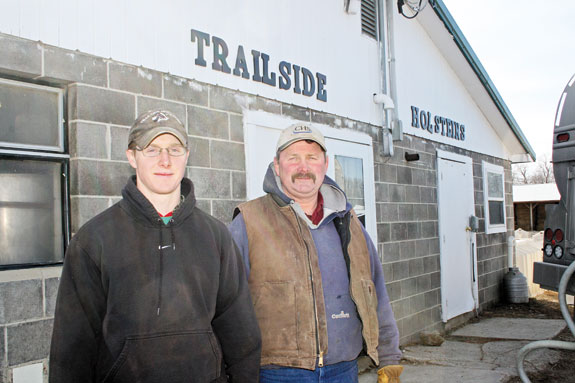
ARTICLE
Sand, the gold standard for dairy cow bedding, is abundant in southern Minnesota. However, the handling needs of sand-laden manure did not always comply with the region’s strict regulations for manure storage structures. One environmental engineer developed a system that would satisfy both the dairies and the regulators.
Arlo Habben, president of Southern Minnesota Agronomic Environmental Services (SMAES), modified the weep cell work of Joe Harner from Kansas State University to create a two-stage dairy and wastewater treatment system.
Manure mixed with bedding (sand or otherwise) is scraped from barns over a five-foot to six-foot ledge into the first storage area. There, the liquids seep towards screen-lined towers where they are drained via pipes into a liquid storage basin.
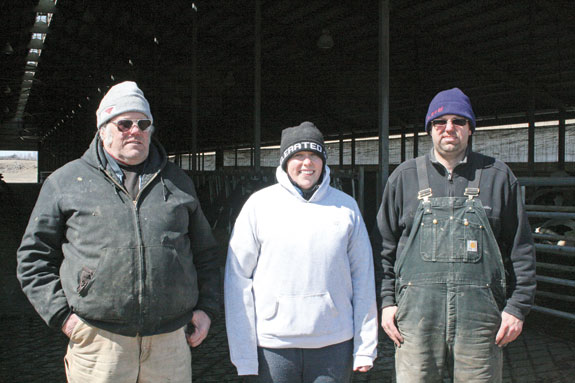
This separation occurs by gravity and without any moving parts.
“No pumps, no frills, it’s simple,” Jon Johnson says. “Plus it’s environmental- and government- friendly.”
Johnson uses this system on his dairy in Fountain, Minnesota. In partnership with his son, Michael, the Johnsons milk 420 cows, raise 450 youngstock and maintain 1,200 acres of cropland.
The dairy has been using sand bedding since 1996, and the herd was averaging 29,800 pounds of milk in March of this year.
Because the liquid basin contains just .25 to .5 percent solids, under Minnesota regulations they can be earthen lagoons with a plastic lining.
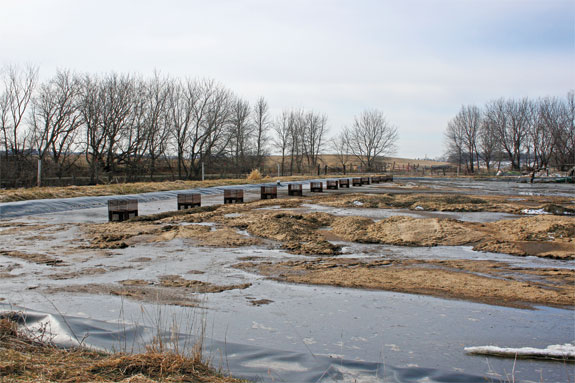
At less than .5 percent solids, the environment in the liquid basin is ripe for purple sulfur bacteria. These naturally occurring bacteria feed on ammonia, hydrogen sulfide and organic compounds that cause odor.
“Odor from this system is, by far, many times better than before,” Johnson says. With a public bike trail cutting through his farm and within 50 feet of the manure storage, odor control is a real benefit.
One trick Johnson also uses is to not dump waste milk into the manure system. That milk is fed, sold to a neighbor or applied directly on the land.
Habben also designed a smaller, two-stage system for parlor washwater. From his years of experience, he knew he didn’t want to add extra water to the system.
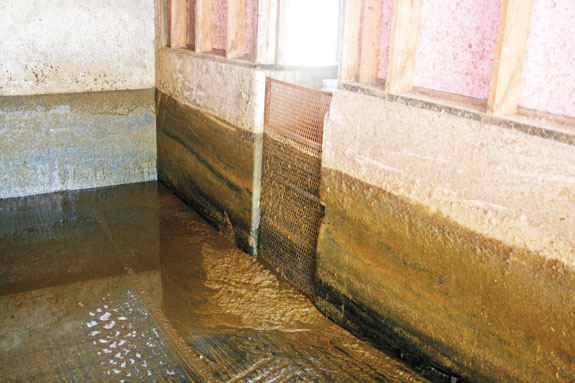
Therefore, parlor water runs through a separate filter and directly into the liquid storage.
The liquid basin is emptied throughout the summer with irrigation via center pivots or walking guns. It is typically applied over alfalfa. High in potassium, the legume crops love it, Habben says.
The Nelson family at Birchwood Gap Dairy in Caledonia, Minnesota, uses a walking gun to irrigate the liquids onto 26 acres next to their manure storage. This is done after each cutting of hay (about four to five times a year).
Testing of their liquid basin revealed a moisture content of 99.7 percent. This low solids content is reflected in a very low nitrogen level of 3 pounds per 1,000 gallons and phosphorus levels at 1 pound per 1,000 gallons.
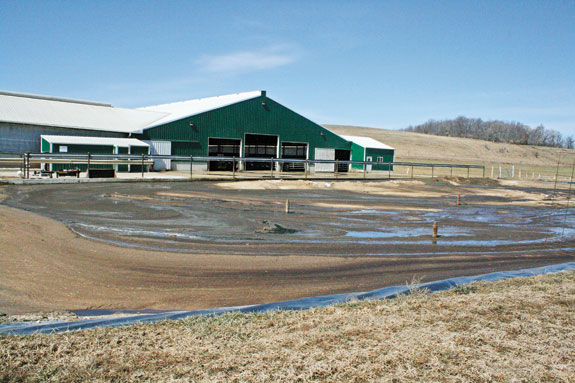
When tested using a more accurate irrigation liquid test, the amount of phosphorus was equal to .1 pound per 1,000 gallons.
Removing the added weight and volume of the liquids from the solid manure system is a big advantage, states Eric Nelson II, who farms with his parents and sisters at Birchwood Gap Dairy. Now, it is much easier to transport the nutrient-laden materials to fields further away from the 340-cow dairy.
Solids remaining in the first stage can be hauled with a spreader. An operator can take out as many loads as they want at any given time without having to remove liquid to do so.
“It’s made for a better lifestyle not hauling manure every day,” Johnson says. “Today we’re hauling when we can. We are managing the manure; it is no longer managing us.”
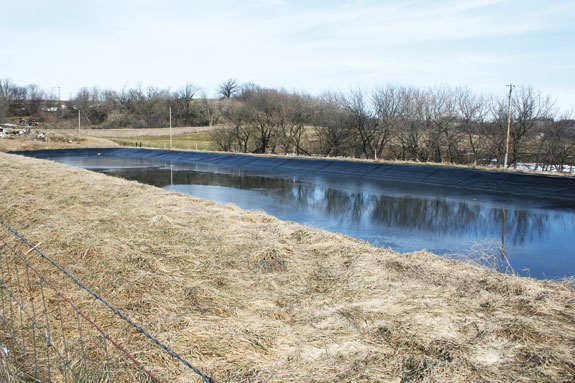
Following the farm’s nutrient management plan, solids from Johnson’s dairy are spread and incorporated at an average rate of 16 tons per acre.
Test results from Birchwood Gap Dairy list the nutrient content of the solids at 8 pounds nitrogen per ton and 4 pounds phosphorus per ton before hauling. They haul this out in the spring and fall to their 300 acres of corn ground.
“You get more bang for your buck in the solids,” Nelson says, noting they are no longer diluted with the liquid portion.
According to Nelson, dust settling in the liquid basin is the biggest drawback to the system because he can’t drive in there to clean it; it must be flushed out with a hose.
During times of extremely cold temperatures, the Nelsons will pile the frozen manure and haul it out versus letting it build up at the edge of the solid basin. However, that is rare, even in Minnesota.
Advantages to the system, other than those previously mentioned, are that it can fit on all different sizes of farms, can be worked into existing manure systems and doesn’t cost any more than putting up storage, Habben says.
Because it uses virtually no mechanics, this system has lower operational costs than other manure separation systems.
The screened towers do require a little maintenance. Fibers from the solids mat over the screen openings. This does help to further screen the liquids, but needs to be cleaned off each time the solid storage is emptied.
The pipes from the solid storage to the liquids should also be cleaned at this time.
According to Habben, this system can save a 200-cow dairy $20,000 to $30,000 a year.
“From an economical standpoint, it’s been really good for us,” Johnson adds.
Manure is now hauled with inside help, which has resulted in a substantial savings for the farm. Johnson says they were paying $50,000 to $60,000 a year for custom hauling, and that was just for the solids. He concedes they do have to pay for labor and machinery now themselves, but it’s not nearly as high. PD
PHOTOS
PHOTO 1: The father-son duo of Jon (right) and Michael (left) Johnson have found this manure system to pay off both in dollars and time.
PHOTO 2: When the Nelson family built a new dairy facility, they opted for a passive separation system. Family members pictured here include, left to right, Eric Nelson I; his daughter, Jennifer Nutt; and his son, Eric Nelson II.
PHOTO 3: Screen-lined towers allow the liquid portion of manure to seep in and drain into a second storage basin.
PHOTO 4: This small screen is used to separate the parlor washwater at Birchwood Gap Dairy in Caledonia, Minnesota.
PHOTO 5: Manure is scraped from the freestall barns at Birchwood Gap Dairy over a ledge and into the first-stage solid basin.
PHOTO 6: Liquids are stored in a plastic-lined earthen lagoon. All photos by Karen Lee.

-
Karen Lee
- Progressive Dairyman Midwest Editor
- Email Karen Lee






